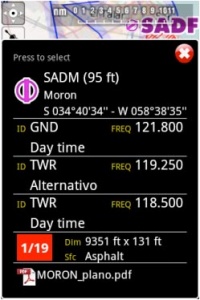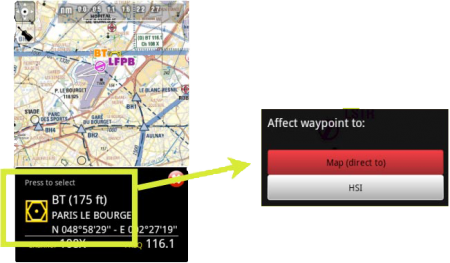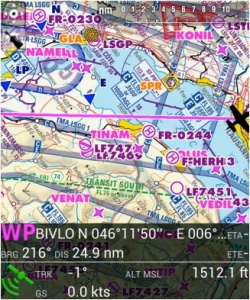Il est possible de créer un itinéraire à partir de la carte principale. En plus, vous pouvez ajouter des points de navigation intermédiaires à votre itinéraire de vol (afin d’éviter des mauvaises conditions météorologiques par exemple).
Par défaut, la carte est centrée sur votre lieu actuel et orientée au Nord. En pressant sur le symbole en haut dans le coin à gauche, vous pouvez basculer entre:
En touchant une zone interactive sur le carte, une fenêtre apparaîtra avec des informations utiles. Les zones interactives sont:
Waypoints: code ID, élévation, type de symbole, nom complet, latitude, longitude, fréquences (Navaids), piste et fréquences de contact (Aérodromes) cartes d’approche géo-référencées.
Espaces aériens: limites inférieures et supérieures, nom, classe et informations supplémentaires. Ces espaces aériens sont affichés sur la carte en différentes couleurs selon leurs type.
You can press on any of the waypoints in the map to assign it to the HSI instrument or to select it as your destination, by pressing where it says: Press to select
The data bar at the bottom of the moving map will display real-time information. From left to right: ID and name of next waypoint; bearing, track and distance of next waypoint; groundspeed and altitude as reported by the GPS signal, and estimated time to the next waypoint.
The data bar also shows a GPS signal symbol as follows:
Excellent GPS signal
Good GPS signal
Weak GPS signal
Very week GPS signal
For real time navigation, the quality of the GPS signal is required to be a green or yellow symbol. A red or orange symbol will only show an approximate location and will not report speed nor track information.For better results, place your device near a window, with a direct view of the sky. If you are flying with a full-metal airplane or your airplane is equipped with anti-ice windshield, the internal GPS of your tablet/mobile may be a bit weak and you may need an external GPS device to assist it.
Back to index.





